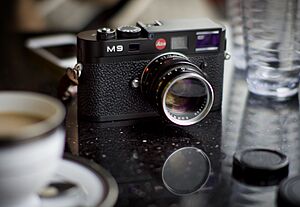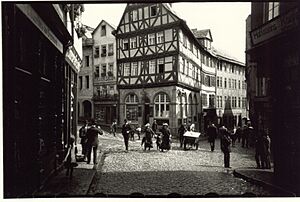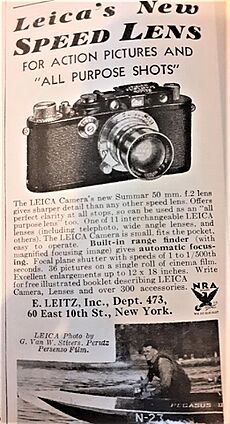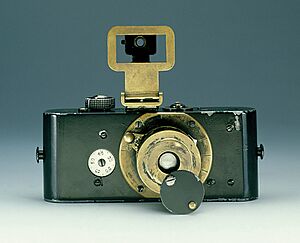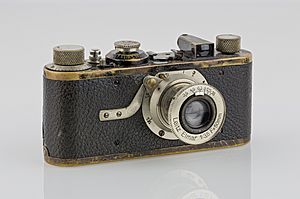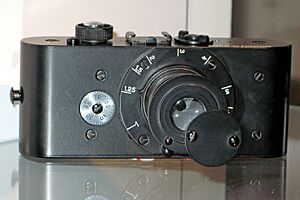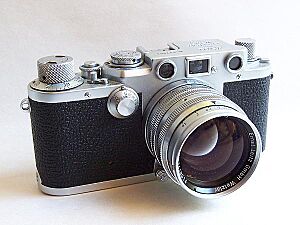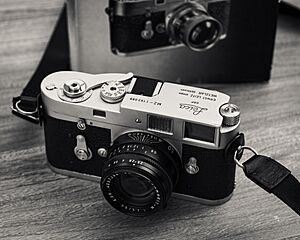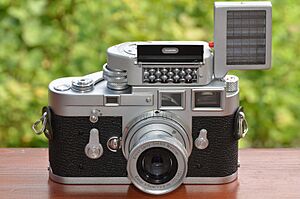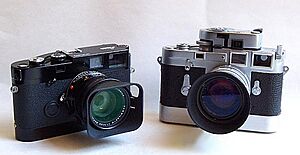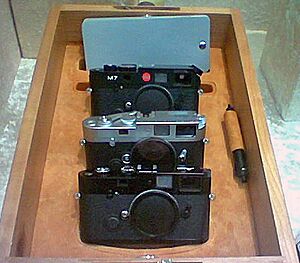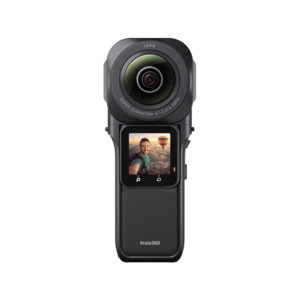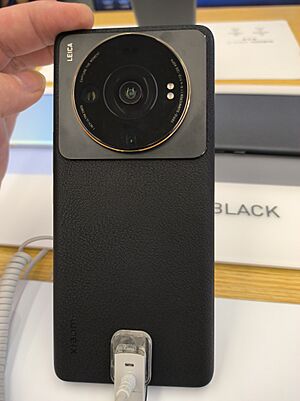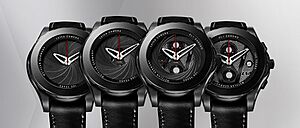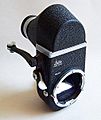Leica Camera facts for kids
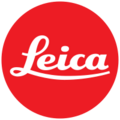 |
|
| Aktiengesellschaft | |
| Industry | Rangefinder camera, Photography, Digital Imaging, Still cameras, SLR cameras, DSLR cameras, binoculars / Monoculars, binocular telescope, laser rangefinder ophthalmic lenses |
| Founded | 1869 in Wetzlar, Germany (Ernst Leitz Wetzlar); 1986 in Solms, Germany (Leica) |
| Headquarters | Wetzlar, Germany |
|
Key people
|
Andreas Kaufmann (Chairman, Supervisory board), Matthias Harsch (CEO) |
| Products | Cameras, photographic lenses, binoculars, ophthalmic lenses and other optical equipment |
| Revenue | |
| Owner | ACM Projektentwicklung GmbH (55%) The Blackstone Group (45%) |
|
Number of employees
|
1800 |
Leica Camera AG is a German company famous for making high-quality cameras, optical lenses, and binoculars. It also makes rifle scopes. The company started in 1869 in Wetzlar, Germany, by Ernst Leitz. Its original name was Ernst Leitz Wetzlar. The name Leica comes from the first three letters of the founder's last name (Leitz) and the first two letters of the word camera: Lei-ca (LEItz CAmera).
In 1986, the company changed its name to Leica and moved its factory to Solms, a town nearby. Today, Leica Camera AG is mostly owned by an Austrian investment company, ACM Projektentwicklung GmbH (55%), and The Blackstone Group (45%).
Leica moved its main offices and factories back to Wetzlar in 2014. They opened a new campus called Leitz Park. This campus has their manufacturing, research, and a special center for customers. Leica is still known for its high-end cameras, like the M-series rangefinder cameras and the Q-series compact cameras.
Leica also works with other companies. They have helped Panasonic with optical designs for Lumix cameras. They also worked with Huawei and Xiaomi to improve camera technology in their smartphones. Leica is a respected name in photography, known for its precise engineering and famous lenses like the Summicron and Noctilux.
Contents
How Leica Started
The first Leica factory buildings were built in Wetzlar from 1907 until the 1950s. The factory stayed there until 1986 when it moved to Solms. The original factory had a unique design, fitting into the landscape near Kalsmunt Castle.
In the late 1800s, Ernst Leitz expanded his production of optical devices. This led to the construction of some of the first tall buildings in Wetzlar. The earliest part of these buildings was designed in 1907. It was a four-story building with many windows. A few years later, in 1911, another four-story building was added.
In the early 1930s, a new seven-story building connected the two older tall buildings. This building was designed to be even taller, with eight floors, and was completed in 1938. In 1950, another nine-story building was added.
Early Leica Cameras
The very first 35 mm film Leica prototypes were made by Oskar Barnack at Ernst Leitz Optische Werke in Wetzlar in 1913. Some people say the original Leica was meant to be a small camera for taking pictures of landscapes, especially during mountain hikes. Other sources say it was for testing 35mm movie film. The Leica was the first practical 35 mm camera that used standard cinema film. It moved the film horizontally, making a larger picture size of 24×36mm.
In 1923, Barnack convinced his boss, Ernst Leitz II, to make 31 cameras for testing. Even though the test cameras got mixed reviews, Ernst Leitz decided in 1924 to produce the camera. It became very popular when it was shown at the 1925 Leipzig Spring Fair as the Leica I.
The first Leica lens was a 50 mm lens designed by Max Berek at Leitz. It was first called the Leitz Anastigmat, then the ELMAX. By 1925, an improved version called the ELMAR was designed. Max Berek named some Leica lenses after his dogs, Hektor and Rex.
In 1930, the Leica I Schraubgewinde was made. It had lenses that could be changed using a screw thread. This is often called the Leica Thread Mount (LTM). In the mid-1930s, a special lens called the Thambar 90 mm was designed. It made pictures look soft and dreamy. Only a few were made, making them rare collector's items today.
The Leica II came out in 1932. It had a built-in rangefinder to help photographers focus. This model had a separate viewfinder and rangefinder. In 1932, the distance from the lens to the film was standardized to 28.8mm.
The Leica III added slower shutter speeds, down to 1 second. The IIIa model added a very fast 1/1000 second shutter speed. The IIIa was the last model Barnack was fully responsible for before he passed away. Leitz continued to improve this design until 1957.
Early Leica cameras had "D.R.P." on them, which meant "Deutsches Reichspatent" (German Empire Patent). This referred to a German patent granted to Ernst Leitz in 1923.
The company had fair policies for its workers, many of whom were Jewish. Ernst Leitz II, who ran the company from 1920, helped many Jewish people leave Germany after Hitler came to power in 1933. He "assigned" them to overseas sales offices, even if they weren't actual employees, to help them find jobs. This effort became known as the "Leica Freedom Train" and continued until the borders closed in 1939.
After World War II
After World War II, Leitz kept making later versions of the Leica II and Leica III cameras. In 1954, Leitz introduced the Leica M3. This new camera had a new Leica M mount for lenses, which was like a bayonet. The M3 also combined the rangefinder and viewfinder into one large, bright window. This made focusing easier and more accurate. Leica still makes improved versions of this model today.
In 1952, Günther Leitz decided to open a factory in Midland, Ontario, Canada, called Ernst Leitz Canada.
Post-war models had "DBP" on them, meaning "Deutsches Bundespatent" (Federal German Patent). Many other camera companies made cameras similar to the Leica rangefinder design. These included companies like Canon in Japan and FED in the USSR.
Leica also made single-lens reflex (SLR) cameras starting in 1964 with the Leicaflex. Later, they made the R series in partnership with Minolta Corporation. The Leica R8 was fully designed by Leica. The last model was the Leica R9. The R-series was stopped in 2009.
Leica also had the Leica Visoflex System. This was a special mirror box that attached to Leica rangefinder cameras. It allowed them to use longer lenses, which are harder to focus with a regular rangefinder. Leica has made many important improvements in lens design over the years.
From 'Leitz' to 'Leica'
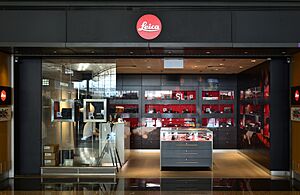
In 1986, the Leitz company officially changed its name to Leica. This was because the Leica brand name was already very famous. At this time, Leica moved its factory from Wetzlar to Solms, Germany. In 1996, Leica Camera became a separate public company. In 1998, the larger Leica group split into two independent companies: Leica Microsystems and Leica Geosystems.
In 2012, Leica Camera AG was removed from the Frankfurt Stock Exchange. This happened after Lisa Germany Holding GmbH bought all the remaining shares, making the company privately owned.
In 2013, Leica Camera AG bought Sinar Photography AG, a Swiss company that makes special view cameras.
In May 2014, Leica Camera AG finished building a new factory in Wetzlar and moved back to the city where it all began.
In 2019, a commercial for Leica called "The Hunt" was released online. It showed photojournalists in difficult situations. Leica later removed the commercial and said they did not approve its production.
In September 2022, Leica announced a new laser projector called Cine 1. It was released in 2023. This marked Leica's return to making digital projectors.
Famous Photographers Who Used Leica
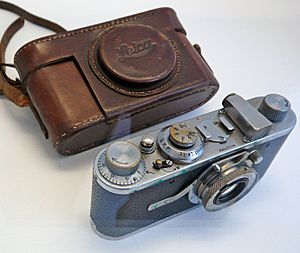
Leica cameras are especially known for being used in street photography. Many famous photographers, like Henri Cartier-Bresson and Sebastião Salgado, used them.
Collecting Leica Cameras
Leica cameras, lenses, and accessories are popular items for collectors. There are many books and guides for Leica collectors. Old or rare cameras and accessories can sell for very high prices. For example, a rare 1923 Leica camera was sold for 2.6 million euros (about $2.8 million) at an auction in Vienna. Leica cameras with military markings are also very valuable.
Leica Camera Models
The first Leica prototypes were made in the early 1900s, but they were sold starting in the mid-1920s. Leica cameras were special because they turned the 35 mm film sideways, unlike movie cameras. This made the picture frame wider. The cameras were also small and had lenses that could fold, making them good for hiking.
In 1932, the Leica II added a rangefinder to help with focusing. That year, cameras with both rangefinders and viewfinders became available with lenses that could be changed. In 1933, the Leica III offered slow shutter speeds and a fast 1/1000 second speed. Different versions of the III series became very popular until the late 1950s.
Before WWII, Leica and Contax cameras from Zeiss Ikon were considered the best 35 mm cameras. After the war, they faced competition from copies made in the Soviet Union and Japan. In the 1950s, Japanese cameras became very good and affordable, which hurt European camera companies. Leica cameras became expensive and were mostly bought by professional photographers.
The original company, Ernst Leitz GmbH, is now three separate companies: Leica Camera AG (for cameras), Leica Geosystems AG (for survey equipment), and Leica Microsystems GmbH (for microscopes). Leica Microsystems GmbH owns the Leica brand name and lets the other two companies use it.
Partnerships and Collaborations
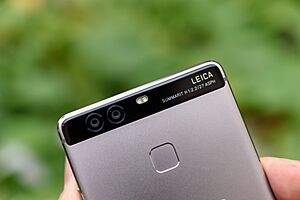
At a big photography show in 2018, Leica announced that Sigma and Panasonic could use its L-mount platform for lenses. These three companies formed a partnership.
Leica-branded lenses have been used on many Panasonic digital cameras (Lumix) and video recorders since 1995. Panasonic/Leica models were the first to include optical image stabilization in their digital cameras.
Leica and Minolta also worked together starting in 1972.
- Minolta's XE camera body was used for the Leica R3 SLR camera.
- Minolta's XD camera body was used for the Leica R4 SLR camera.
- They also worked together on lenses for these cameras.
- Leica and Minolta also created the 'Leitz-Minolta' CL and CLE (Compact Leica Electronic) cameras. Minolta helped design and make lenses for these cameras.
In 2020, Leica partnered with Insta360 to help make the ONE R 1-Inch Edition camera. This camera was named one of TIME magazine's best inventions of 2020.
From 2016 to 2021, Leica partnered with the Chinese company Huawei. Leica cameras were put into Huawei smartphones, including the P series and Mate series. The Huawei P9 was the first smartphone with a Leica co-engineered camera.
In 2021, Leica partnered with Sharp Corporation to put Leica cameras into Sharp smartphones for the Japanese market. The AQUOS R6 was the first Sharp smartphone with a 1-inch-sensor camera co-engineered with Leica. Then, Leica and SoftBank introduced the Leitz Phone 1, which had similar features to the AQUOS R6 but a different design.
In 2022, Leica started a partnership with Xiaomi to develop Leica cameras for Xiaomi's top smartphones. The first phones from this new partnership were the Xiaomi 12S Ultra and Xiaomi MIX Fold 2, released in July and August 2022.
In 2014, to celebrate Leica camera's 100th anniversary, they partnered with a Swiss watchmaker called Valbray. They created a special limited edition wristwatch with a dial inspired by a camera lens.
Images for kids
See also
 In Spanish: Leica para niños
In Spanish: Leica para niños


